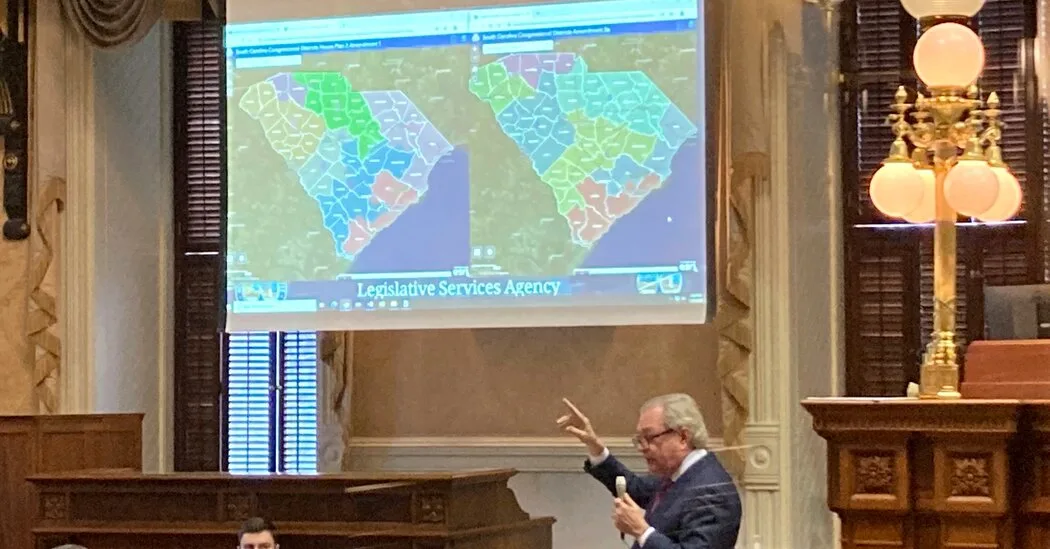
Members of the Supreme Court struggled to disentangle race and politics in the voting districts drawn by state lawmakers.
The Supreme Court heard arguments on Wednesday on a constitutional puzzle from South Carolina: how to disentangle the roles of race and partisanship in drawing voting maps when Black voters overwhelmingly favor Democrats. The difference matters because the Supreme Court has said that only racial gerrymandering may be challenged in federal court as constitutionally suspect.
A unanimous three-judge panel of the Federal District Court in Columbia, S.C., ruled in January that the state’s First Congressional District, drawn after the 2020 census, violated the Constitution by making race the predominant factor.
Several members of the Supreme Court’s conservative majority seemed unpersuaded by the lower court’s findings and reasoning on Wednesday. They said the evidence that Republican state lawmakers had used race as the predominant factor was circumstantial and consistent with something that is legally acceptable: trying to achieve the purely partisan goal of creating a district with a distinct conservative tilt.
“Disentangling race and politics in a situation like this is very, very difficult,” Chief Justice John G. Roberts Jr. said. A ruling for the challengers, he added, “would be breaking new ground in our voting rights jurisprudence.”
But Justice Elena Kagan told a lawyer for the lawmakers that “the evidence showed that you were using race as a proxy for politics.” She added that data on racially polarized voting may be more reliable than data about given election results.
The case is superficially similar to one from Alabama in which the court ruled in June that state lawmakers had diluted the power of Black voters in drawing a congressional voting map. But the two cases involve distinct legal principles.
The Alabama case was governed by the Voting Rights Act, the landmark civil rights statute, and the one from South Carolina by the Constitution’s equal protection clause. The two can tug in opposite directions.
The challenged district, anchored in Charleston, had elected a Republican every year since 1980, with the exception of 2018. But the 2020 race was close, with less than one percentage point separating the candidates, and Republican lawmakers “sought to create a stronger Republican tilt” in the district after the 2020 census, the lower-court panel wrote.
The lawmakers achieved that goal, the panel found, in part by the “bleaching of African American voters out of the Charleston County portion of Congressional District No. 1.”
The new House map moved 62 percent of Black voters in Charleston County from the First District to the Sixth District, a seat that Representative James E. Clyburn, a Black Democrat, has held for 30 years.
The move helped make the new First District a Republican stronghold. In November, Nancy Mace, the Republican incumbent, won re-election by 14 percentage points.
The demographics of her new district may have figured in Ms. Mace’s recent shift to the right, as evidenced by her decision to join seven hard-core conservatives to oust Representative Kevin McCarthy from the speaker’s chair.
Republican lawmakers acknowledged that they had redrawn the First District for partisan gain. But they said they had not considered race in the process.
The panel ruled that the district’s boundaries must be redrawn before future elections are held. But the panel rejected challenges to two other House voting districts, saying that civil rights groups had failed to demonstrate that the districts had been predominantly drawn to dilute Black voting power.
The Supreme Court has called for close scrutiny of a state’s actions when race was shown to be the predominant reason for drawing legislative districts. That principle is often invoked to limit the creation of districts that empower minority voters.
In the new case, Alexander v. South Carolina State Conference of the N.A.A.C.P., No. 22-807, the challenge came from the opposite direction, and said that the map hurt Black voters by moving them from one congressional district to another.
Republican legislators said that they had deliberately avoided looking at the racial breakdown of the new map to insulate themselves from charges of bias, a defense that Republicans have increasingly embraced in other redistricting battles.


